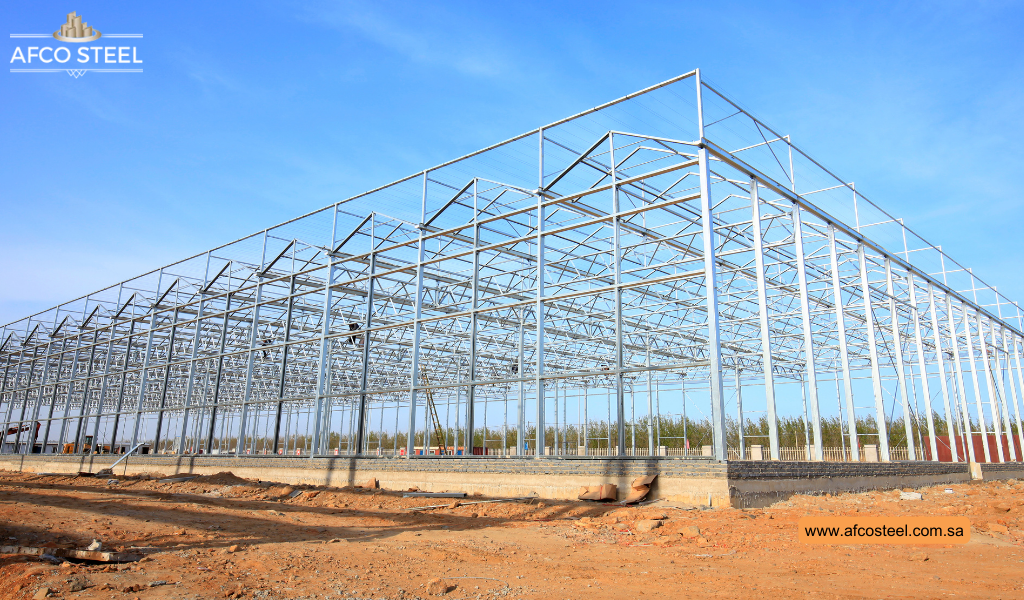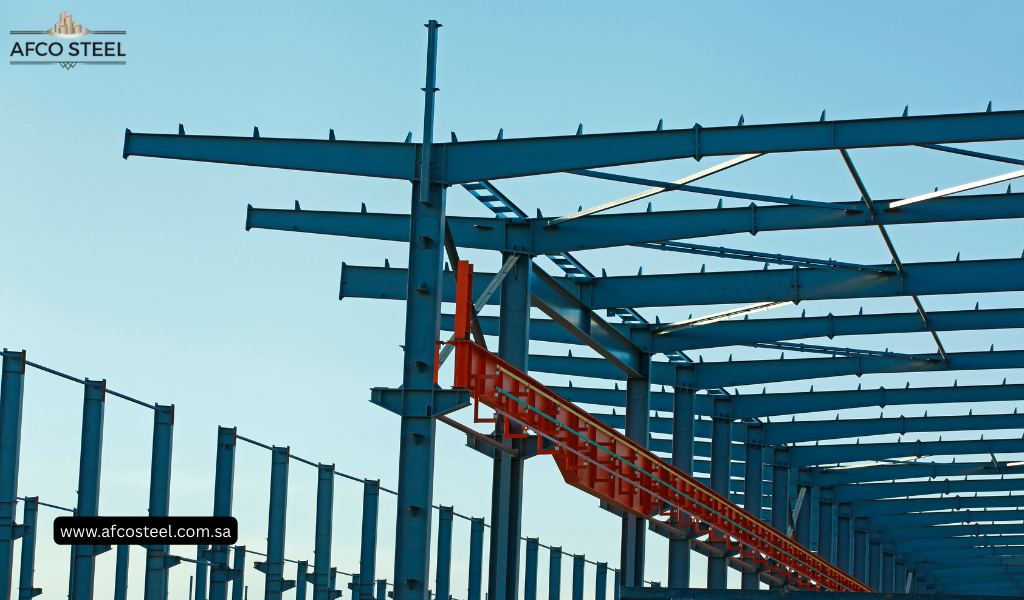The use of structural steel in high-rise and industrial buildings has revolutionized construction in Saudi Arabia. From modern skyscrapers in Riyadh to industrial facilities in Dammam, structural steel provides the strength, durability, and flexibility required for large-scale projects. Understanding how to design and implement structural steel efficiently is crucial for engineers, architects, and construction companies in the KSA market.
This guide covers design considerations, types of steel shapes, related fabrication processes, standards, and benefits of prefabricated solutions that can assist you in making decisions for your upcoming project!
Why Structural Steel is Ideal for High-Rise and Industrial Buildings?
There are many benefits to using structural steel as opposed to more traditional materials, such as concrete. This is durable, light, and faster to build. Moreover, steel structures have high resistance to the wind loads, seismic loadings and extreme temperatures—these are the conditions frequently encountered in the climate of Saudi Arabia.
Key benefits include:
- High strength-to-weight ratio
- Quicker to install than it does with concrete structures
- Design & architecture aesthetic flexibility
- A green construction material that is recyclable and sustainable
Using structural steel allows safety and efficiency, while satisfying the requirements of steel structure standards and codes, in KSA construction projects.
Understanding Structural Steel Shapes in Saudi Arabia
Selecting the appropriate steel section is important for effective load spread, structural performance, and cost efficiency. Some of the commonly Utilized structural steel shapes Saudi Arabia Include:
- I-Beams (Universal Beams) – Most commonly used beams and columns in tall buildings with long spans
- H-Beams– Heavy loads or industrial structures
- Angles & Channels – For braces, frameworks, and secondary support
- HSS Steel (Hollow Structural Sections)— These sections are either cylindrical or rectangular and are also known for their high strength with less weight.
Each steel shape has specific applications based on project requirements. For example, hollow structural sections of steel are often preferred for aesthetic appeal and efficiency in tall structures.

Designing Prefabricated Structural Steel Buildings
The use of prefabrication, which refers to the manufacture and assembly of components and materials before arriving on site, has experienced a rising trend and preference in the Kingdom as it accelerates the construction progress while saving labor resources and minimizing waste. Usually, this type of building includes prefabricated structural steel components, manufactured in a factory and assembled on-site for faster construction and minimal errors.
Advantages of prefabrication include:
- It will also lead to quicker construction times and lower labor expenses,
- Higher precision and quality control
- Minimal waste of material, aiding in sustainability
- Make it easy to scale or change at a later date
Prefabricated steel structures are resilient and robust, two characteristics that make them good candidates for industrial facilities targeted for projects in KSA, which are exposed to extreme climates.
Selecting Structural Steel Suppliers in KSA
By relying on renowned structural steel suppliers KSA, you gain access to quality materials adhering to local standards. When selecting a supplier, consider:
- Availability of certified steel grades
- All types of structural steel shapes Saudi Arabia for your project
- Timely delivery and logistics support
- Conformance to standards and codes for structural steel
A reliable supplier will also help with techniques to maximize steel efficiency, cut costs, and facilitate prefabricated solutions for industrial and high-rise buildings.
Fabrication and Testing of Structural Steel
Steel becomes ready and thanks to the fabrication process, begins its new life as a part ready to become a part of something bigger, and all this before testing it and making it strong and robust enough to make it the starting point of our journey in safety and comfort. Typical steps include:
- Bending and shaping Steel per design
- Welding or bolting components together
- Surface treatment to prevent corrosion
- Structural steel load and stress testing Standards and Codes
This is as long as you make sure your fabrication and testing are up to par — in any high-rise building, structural integrity cannot be negotiable.
Hollow Structural Sections Steel: Applications and Advantages
Hollow structural sections of steel (HSS) are used more and more in columns, beams, and load bearing frameworks in Saudi Arabia. Key advantages include:
- Uniform strength distribution
- Lightweight yet high-strength performance
- This is aesthetic for those civil structural parts that are not exposed to visible effect.
- Resistance to torsion and bending
HSS steel, for example, is especially beneficial in industrial buildings with long spans and open floor plans.
Structural Steel Standards and Codes in KSA
Following structural steel standards and codes is essential to ensure safety, reliability and compliance with laws. Saudi Arabia often refers to the following key standards:
- Saudi Building Code(SBC) for steel structures
- ASTM and ISO standards for steel grades and testing
- Local fire resistance, wind loads and seismic requirements
Compliance with these guidelines is crucial for the approval of the project, safety, and lastingness of the construction.
Related Blog: Benefits of Local Structural Steel Suppliers in the Saudi Construction Market
Cost Considerations: Structural Steel in Saudi Arabia
The cost of structural steel is per ton in Saudi Arabia which allows you to plan your budget and procurement accordingly. Prices vary based on:
- Steel grade and specifications
- Shape and size of components
- Supplier and delivery logistics
- Project scale and prefabrication requirements
While ensuring quality, they can also be cost-optimized by partnering with time-certified suppliers.
Design Tips for High-Rise and Industrial Projects
Be sure to consider the following in designing structural steel of very big buildings in KSA –
- Use proper steel shapes for load distribution
- Use prefabricated components to reduce construction time
- Ensure proper corrosion protection for harsh climatic conditions
- Referring to structural steel general standards and codes from time to time during the design and the fabrication activities
- Partner with suppliers to ensure excellent quality
This ensures the safe and cost-effective construction of a building that satisfies the functional and aesthetic demands.
Conclusion
Designing structural steel for high-rise and industrial buildings in Saudi Arabia requires a careful balance of strength, cost, and efficiency. By selecting the right Structural Steel shapes Saudi Arabia, partnering with reliable structural steel suppliers KSA, and following structural steel standards and codes, engineers and developers can achieve projects that are safe, sustainable, and durable. Prefabricated solutions and hollow structural sections of steel further enhance construction speed and flexibility, making steel the material of choice for modern KSA construction.
By investing in design, fabrication, and material selection, you can ensure that your high-rise or industrial building will stand the test of time and maximize cost-estimating efficiency.
FAQs about Structural Steel
1. What are the different types of structural steel shapes and when to use them?
Common types include I-beams, H-beams, angles, channels, and HSS. Each is used based on load, span, and design requirements.
2. How much does structural steel cost per ton in Saudi Arabia?
Prices vary by grade, shape, and supplier, typically ranging between SAR 2,500–4,500 per ton, depending on specifications.
3. Benefits of prefabricated structural steel buildings in KSA climate
Prefabricated steel reduces construction time, withstands harsh weather, and supports sustainable building practices.
4. What standards apply for structural steel in Saudi Arabia?
Saudi Building Code (SBC), ASTM, ISO standards, and local fire and seismic regulations govern steel design and fabrication.
5. How is structural steel fabricated and tested for strength and safety?
Steel is cut, welded, and assembled, then tested for load, stress, and durability according to standard codes.

